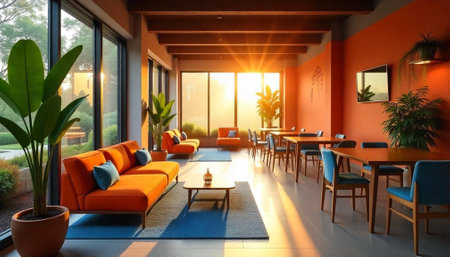Understanding Feng Shui Principles in Modern Living
Feng Shui, an ancient Chinese art, focuses on creating harmony and balance in our surroundings. When we talk about blending Feng Shui with American interior design trends, it’s all about making homes feel inviting, comfortable, and full of good energy. Even if you’re new to Feng Shui, its core ideas can fit perfectly with the way many Americans like to decorate their homes: open spaces, practical layouts, and a cozy atmosphere.
What is Feng Shui?
Feng Shui literally means “wind” and “water.” It’s based on the idea that everything around us has energy (called “chi”), and the way we arrange our furniture and decor can affect how that energy moves through our home. The goal is to let positive energy flow freely while avoiding blockages that might create stress or discomfort.
Key Concepts of Feng Shui
| Feng Shui Principle | How It Works | Modern American Application |
|---|---|---|
| Energy Flow (Chi) | Keep pathways clear and avoid clutter so energy can circulate smoothly. | Open floor plans, organized spaces, minimal clutter. |
| Balance (Yin & Yang) | Create a mix of calm (yin) and lively (yang) elements for a balanced vibe. | Combine soft fabrics with bold colors or patterns; mix lighting types. |
| The Five Elements | Wood, Fire, Earth, Metal, Water—each adds a different type of energy to a space. | Add plants (wood), candles (fire), ceramics (earth), metal frames (metal), water features (water). |
| The Bagua Map | This tool divides your home into zones connected to life areas like health or career. | Highlight the entryway for career luck; boost family area with meaningful photos. |
Aligning Feng Shui with American Lifestyles
Today’s American homes often focus on comfort, functionality, and personal expression. These values align well with Feng Shui principles:
- Energy Flow: Open layouts and multi-use rooms allow movement and flexibility—just what Feng Shui recommends for positive chi.
- Balance: Mixing textures, colors, and materials creates visual interest and emotional comfort. Think of a modern living room with both soft throws and sleek coffee tables.
- Harmony: Choosing natural light, indoor plants, and personalized decor brings together the best of both worlds—American style with an Eastern sense of calm.
The Takeaway
You don’t have to follow every traditional rule to benefit from Feng Shui. By focusing on energy flow, balance, and harmony, you can create a home that feels welcoming and supports your lifestyle—all while staying true to your favorite American design trends.
2. Popular American Interior Design Styles
When blending Feng Shui with American interior design, it’s important to first get familiar with the leading styles that are trending across the United States. Each style reflects different values and aesthetics, but all share a focus on comfort, self-expression, and functionality—qualities that make them especially appealing to American homeowners. Here are some of the most popular:
Mid-Century Modern
This style is all about clean lines, organic shapes, and functional design. Inspired by the 1950s and 1960s, Mid-Century Modern uses wood accents, bold colors, and iconic furniture pieces to create a timeless look. Its popularity comes from its ability to make spaces feel open and uncluttered, which aligns well with the Feng Shui principle of energy flow.
Farmhouse
Farmhouse style celebrates rustic charm and simplicity. It often features shiplap walls, natural wood finishes, white or neutral color palettes, and cozy textiles. Americans love this style because it feels welcoming and lived-in—a perfect backdrop for family gatherings and relaxed lifestyles.
Minimalism
Minimalism focuses on “less is more.” This style uses simple color schemes (often black, white, or gray), streamlined furnishings, and very little clutter. Many homeowners appreciate Minimalism for its calming effect and ease of maintenance. Its emphasis on open space dovetails nicely with Feng Shui’s goal of creating harmonious environments.
Boho Chic
The Boho Chic style is eclectic and free-spirited. It mixes vibrant patterns, textures, global influences, and lots of houseplants. This style appeals to those who want their homes to reflect creativity and individuality while still feeling warm and inviting.
Comparison of Popular American Styles
| Style | Main Features | Why Americans Love It |
|---|---|---|
| Mid-Century Modern | Clean lines, retro furniture, open layouts | Timeless look; makes spaces feel bigger |
| Farmhouse | Rustic details, natural wood, cozy accents | Warmth and comfort; perfect for families |
| Minimalism | Simplicity, neutral colors, uncluttered spaces | Calming atmosphere; easy upkeep |
| Boho Chic | Colorful patterns, plants, global decor | Personal expression; inviting vibe |
Understanding these styles helps you see how Feng Shui can work hand-in-hand with American tastes—combining good energy flow with beauty and practicality for a home that truly feels like your own.

3. Shared Values: Combining Aesthetics and Well-Being
When blending Feng Shui principles with American interior design trends, it’s easy to see that both approaches share a deep appreciation for creating spaces that nurture well-being and reflect personal style. While Feng Shui takes a holistic view, focusing on the flow of energy (chi), balance, and harmony, American interior design often emphasizes comfort, functionality, and self-expression. Let’s explore how these shared values come together in home design:
Synergies Between Feng Shui and American Design Trends
| Feng Shui | American Interior Design | Shared Value |
|---|---|---|
| Balance of elements (wood, fire, earth, metal, water) | Mixing textures and materials for visual interest | Aesthetic Harmony |
| Decluttering to allow free flow of energy | Minimalist or open-concept layouts for ease and comfort | Functional Simplicity |
| Personalized decor based on birth elements or aspirations | Self-expression through art, color choices, and furniture styles | Personal Meaning |
| Nurturing positive energy with light and nature elements | Emphasizing natural light and bringing the outdoors in | Well-Being & Connection to Nature |
Aesthetic Harmony Meets Comfort and Functionality
Both Feng Shui and American design trends value spaces that look good and feel good. For example, arranging furniture to optimize conversation or relaxation aligns with Feng Shui’s focus on harmonious energy flow. At the same time, choosing soft textiles or ergonomic seating fits the American emphasis on comfort.
Encouraging Self-Expression Through Thoughtful Choices
The combination also invites homeowners to express their personalities—whether through meaningful artwork, favorite colors, or special mementos—while still following Feng Shui guidelines for placement and symbolism. This blend encourages homes that are not only beautiful but also deeply supportive of the people who live there.
4. Practical Tips for Seamless Integration
Color Selection: Harmonize Energy and Style
When blending Feng Shui with American interior design, choosing the right colors is key. In Feng Shui, each color represents a different element and energy. Meanwhile, American trends favor neutral palettes with pops of bold color. Here’s a quick guide to help you merge both approaches:
| Feng Shui Element | Suggested Color | American Trend Pairing |
|---|---|---|
| Wood | Green, Brown | Earthy tones with natural wood finishes |
| Fire | Red, Orange | Accent pillows or statement art pieces |
| Earth | Yellow, Beige | Warm neutrals for walls or rugs |
| Metal | White, Gray | Modern metallic fixtures or furniture legs |
| Water | Blue, Black | Navy sofas or black framed mirrors |
Furniture Placement: Balance Flow and Functionality
Feng Shui emphasizes the flow of chi (energy), while American interiors focus on comfort and usability. Try these tips to combine both philosophies:
- Sofa Placement: Place your main sofa against a solid wall for support, but keep space open for easy movement—a win-win for both energy flow and social gatherings.
- Beds: Avoid positioning beds directly in line with doors. Instead, angle them to have a clear view of the entrance without being exposed—great for peace of mind and restful sleep.
- Avoid Clutter: Select multi-functional American-style storage solutions to keep spaces tidy and chi flowing freely.
The Use of Natural Elements: Bring Outdoors In
A key part of Feng Shui is inviting nature indoors. This also aligns well with the popular American trend of biophilic design. Here’s how you can add natural touches that satisfy both styles:
- Add potted plants like jade or bamboo for luck and freshness.
- Use natural materials such as wood, stone, and cotton in furniture and accessories.
- Let in plenty of natural light with sheer curtains or strategically placed mirrors.
- Create small water features like tabletop fountains for calm and focus—these are conversation starters in any American home!
Tying It All Together: Simple Checklist
- Select colors that energize your space but match your personal style.
- Arrange furniture to support easy flow and comfort.
- Add at least one natural element to each room.
- Edit belongings regularly to prevent clutter buildup.
- Personalize spaces with meaningful decor while maintaining balance.
Merging Feng Shui philosophies with American interior trends doesn’t have to be complicated. With these simple adjustments, you’ll create a harmonious home that feels stylish, welcoming, and full of good energy!
5. Real-Life Examples and Success Stories
Bringing Feng Shui into Modern American Homes
Blending Feng Shui with American interior design trends isn’t just a theory—it’s a growing practice among homeowners who want balanced, beautiful, and comfortable spaces. Let’s look at some real-life stories and case studies that show how this unique combination works in everyday homes across the United States.
Case Study Table: Feng Shui Meets American Style
| Homeowner | Location | Design Trend | Feng Shui Technique Used | Result |
|---|---|---|---|---|
| Susan & Mark | Austin, TX | Mid-Century Modern | Placed plants in the east for family harmony; added mirrors to reflect natural light. | Their living room feels brighter, and they report fewer family arguments. |
| Brianna H. | Seattle, WA | Boho Chic | Used earth tones and natural textures; rearranged furniture for energy flow. | The home feels cozier, and Brianna says she sleeps better at night. |
| The Jacksons | Atlanta, GA | Farmhouse Style | Decluttered entryway; placed a water fountain near the front door for prosperity. | The family noticed more visitors and felt more connected with neighbors. |
| Carlos M. | Phoenix, AZ | Minimalist Modern | Kept decor simple; used metal accents for clarity and focus in his office. | Carlos says productivity improved and his space feels less stressful. |
Anecdote: A Suburban Success Story
A young couple in Chicago wanted to merge Scandinavian simplicity with Feng Shui principles. They used pale woods, soft textiles, and organized their space so that their sofa faced the door—a classic Feng Shui tip for inviting opportunities. After making these changes, they shared that friends often comment on how welcoming their home feels, and they themselves feel more relaxed after a long day at work.
Why These Approaches Work So Well Together
The success stories above show that combining Feng Shui with popular American styles like farmhouse, modern, or boho isn’t about sacrificing personal taste. Instead, it’s about enhancing comfort, flow, and positive energy using intentional design choices. Homeowners report feeling happier, experiencing better relationships, or simply enjoying their space more—proving that this blend is as practical as it is stylish.


